ISLAMABAD - India has expressed its willingness to change the design of Ratle Dam (850mw Hydropower Generation Project) being built on Chenab River in Indian held Kashmir.
Following the reservations and serious concerns raised by Pakistani authorities during talks with Indian authorities so far held on water related bilateral issues, the later has now expressed its readiness and willingness to change the design of the dam. Moreover, India has also conveyed her willingness to reduce the height of spillways being built for two dams on the site and as a result to change in the design capacity of water storage would decrease in the dams, official sources at Water and Power Ministry told on Monday.
The sources also said that the Indus Water Commissioner has raised objections on Ratle Dam project with India and two rounds of talks between concerned authorities of both countries have been held so far to resolve the differences. They also told that soon an Indian delegation would visit Indus Water Commissioner Lahore and review over the design of Indian water and power project would be made.
India had awarded this project to a private company for 35 years. Under the deal, the private firm would construct and operate the project and after the passage of 35 years, it would hand over the project to the Indian government.
"Water flow at Head Mirallah will reduce by 40 per cent due to construction of Ratle Dam project. Fertile agri land of Pakisrani Punjab would got affected with this Indian project," said the sources.
The foundation stone for the Ratle Dam at village Drabshala, in Kishtwar Sub-division in Indian held Kashmir, was laid by the Indian Prime Minister Dr. Manmohan Singh and Chairperson - Sonia Gandhi in June 2013.
This is the first IPP hydropower project in the Indian held Kashmir awarded on tariff based International Competitive Bidding (ICB) to be implemented on BOOT basis for a period of 35 years.
The Chenab River is a major river of Indus River System, originating from the Lahaul and Spiti district of Himachal Pradesh, India, and flows through the Jammu & Kashmir into the plains of the Punjab, Pakistan. The Chenab waters are allocated to Pakistan under the terms of the Indus Waters Treaty.
The area around the project is located in inner part of Himalayas and represents rugged topography with very high relief. The area is drained by number of streams and tributaries of River Chenab. The River has deep and narrow gorges on both sides of proposed weir sites. The entire course of river is through high cliffs rising two to five thousand feet above the river bed on either side and through very rugged and mountainous region except for a very small length of about 32 km between Reasi and Aknoor which afterwards is joined by the Tawi beyond which the river enters the Sialkot district of Pakistan.
It is significant to mention here that total area drained by the river up to Pakistan is 22,662 square Kilometer out of which 4662 sq km miles are under glaciers. The project area lies in zone-IV of the seismic zoning map of India.
The Ratle project site lies between the Dulhasti HEP (390 MW) on its upstream, which became operational in 2007 and has been generating 1907 GWh (million units of electricity) and the Baglihar HEP (450 + 450 MW) on its downstream. The project site is located about 25 km from Kishtwar town. The installed capacity of the project is 850 MW based on hydrology and power potential studies by Power Development Department of GoJ&K.
Saturday, November 23, 2024
India ready to alter dam design being built on Chenab

Caption: India ready to alter dam design being built on Chenab
RDA suspends Metro operations in guise of routine maintenance
November 23, 2024
RCCI urges to intensify collective efforts for addressing smog issue
November 23, 2024
-
Digital nomadism redefines work and travel across the globe
-
Digital nomadism redefines work and travel across the globe
-
Lahore tops global pollution rankings as smog worsens, AQI reaches hazardous levels
-
Hunger crisis to increase in South Sudan, warns UN
-
Pakistan’s judiciary champions climate justice at COP29 in Baku
-
Punjab struggles with persistent smog as Met Office forecast rainfall
Paper Justice
November 23, 2024
No Silver Bullet
November 23, 2024
Reckless Accusations
November 23, 2024
UN Crossroads
November 22, 2024
Smog Trade-off
November 22, 2024
The World: No Longer Livable
November 23, 2024
Unveiling Protein Secrets with AI
November 23, 2024
Outdated Policy
November 23, 2024
Brain Drain
November 23, 2024
Proposal to counter increasing cases of harassment
November 22, 2024
ePaper - Nawaiwaqt
Nawaiwaqt Group | Copyright © 2024





